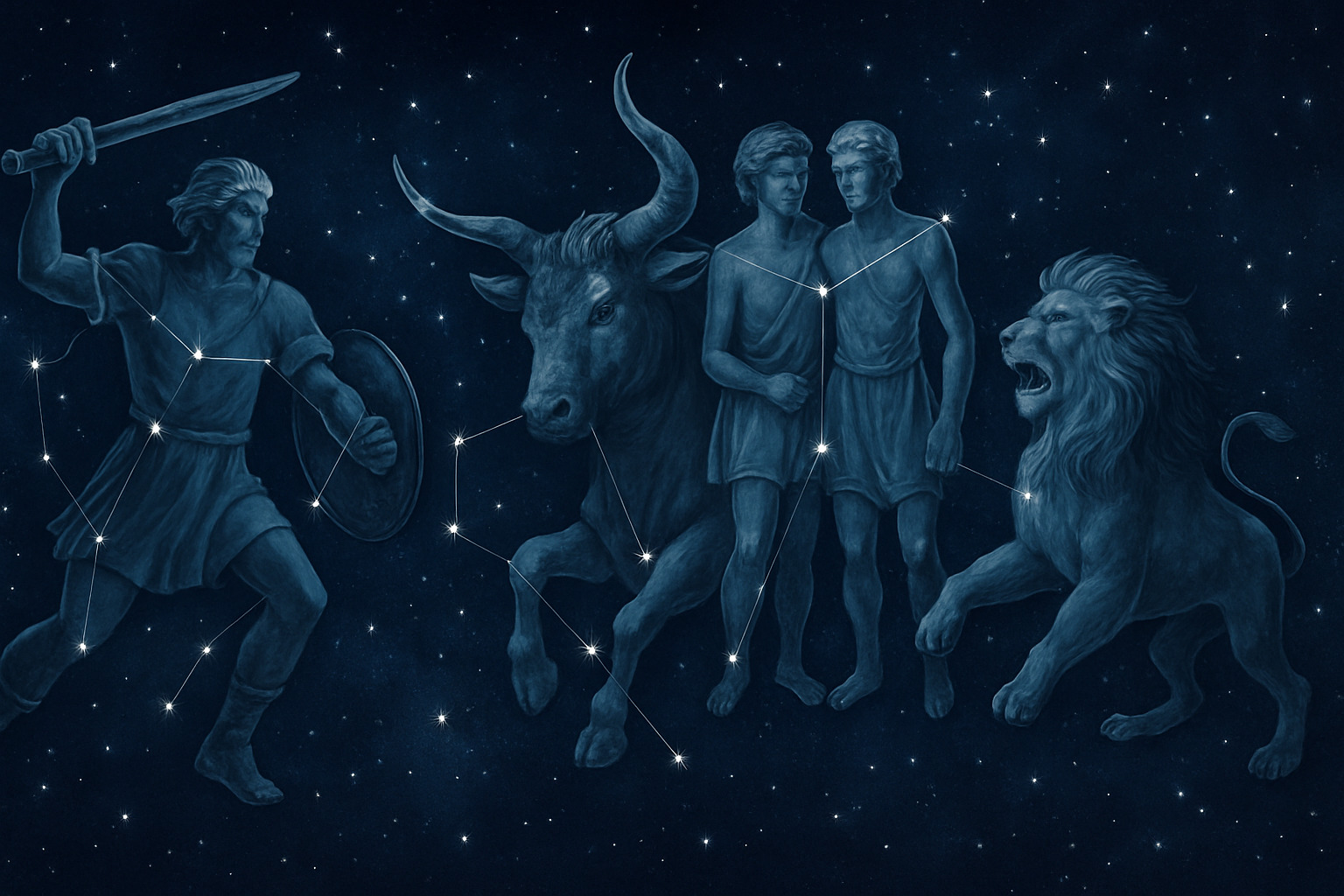Why do constellations carry names rooted in myth and legend? Ancient civilizations connected patterns in the night sky with stories of gods, heroes, and animals. These patterns were not just decorative arrangements of stars; they acted as calendars, navigational tools, and symbols of cultural beliefs. Some of the most recognized constellations today still carry the weight of those myths.
Orion – The Great Hunter
Orion stands out as one of the most famous constellations. Greek mythology describes Orion as a mighty hunter, born of the sea god Poseidon. Stories vary, but many say he was boastful about hunting every creature on Earth, which angered Gaia, the Earth goddess. She sent a giant scorpion to kill him. Zeus later placed Orion in the sky, forever chased by Scorpius, the scorpion constellation, which rises as Orion sets.
Orion’s Belt, a distinctive line of three stars, has been referenced across many cultures. Ancient Egyptians associated these stars with Osiris, god of the afterlife. In astrology, Orion has no direct sign association, but its brightest star, Rigel, is often linked symbolically to power and ambition, qualities commonly tied to Leo.
Taurus – The Bull of the Stars
Taurus has roots in Greek myths involving Zeus. Disguised as a white bull, Zeus abducted Europa, carrying her across the sea. The constellation honors this myth, with the bright star Aldebaran representing the bull’s fiery eye.
In astrology, Taurus is a Zodiac sign representing stability and patience. Interestingly, in Chinese astrology, the Ox shares similar grounded characteristics, making this constellation a shared symbol of perseverance across cultures.
The Pleiades star cluster, also part of Taurus, carries its own story. Greek mythology calls them the Seven Sisters, daughters of Atlas and Pleione. Zeus placed them in the sky to protect them from Orion, who pursued them relentlessly.
Leo – The Lion of Nemea
Leo reflects the Nemean Lion, a beast slain by Heracles during his twelve labors. The lion’s impenetrable hide made it nearly invincible until Heracles strangled it. Hera, who hated Heracles, honored the lion by placing it among the stars.
Astrologically, Leo represents courage, creativity, and leadership. Its association with the Sun adds an additional layer of significance, as many cultures viewed lions as solar animals. The constellation’s brightest star, Regulus, was once considered a royal star by ancient Persians.
Scorpius – The Vengeful Scorpion
Scorpius is forever tied to Orion’s story. The giant scorpion sent by Gaia killed the hunter, leading Zeus to immortalize both creatures in the sky. Their placement ensures that Orion sets before Scorpius rises, symbolizing the eternal chase.
In astrology, Scorpio is a sign associated with transformation and power, reflecting the scorpion’s deadly sting. Ancient Babylonians also viewed Scorpius as a symbol of guardianship, marking the Sun’s passage during the autumn.
Gemini – The Twins of Immortality
Gemini represents Castor and Pollux, twin brothers from Greek mythology. Castor was mortal, while Pollux was immortal. When Castor died, Pollux begged Zeus to let them share immortality. Zeus placed them together in the sky, side by side.
Gemini as a Zodiac sign embodies communication, duality, and curiosity, traits echoing the brothers’ shared yet contrasting nature. Ancient Romans associated the twins with protection of sailors, often invoking them for safe sea voyages.
Virgo – The Maiden of the Harvest
Virgo is linked to Demeter and Persephone in Greek mythology, representing fertility and the harvest. Some interpretations also associate Virgo with Astraea, the goddess of justice, who abandoned Earth during the decline of humanity’s golden age.
In astrology, Virgo symbolizes precision and service, aligning with the myth of a caring and nurturing maiden. Ancient Mesopotamians associated the constellation with agriculture, naming it after Shala, the goddess of grain.
Connections Across Cultures
Many constellations share overlapping interpretations across different civilizations.
- Chinese astronomy often groups stars differently but still links them with animals or legendary figures.
- The concept of houses in astrology ties planetary movement through these constellations, giving each sign specific life themes.
- For instance, Jupiter transiting Taurus is said to bring prosperity, a belief rooted in both Western and Chinese traditions where Taurus and the Ox symbolize abundance.
Why Myths Continue to Matter
Constellations act as a bridge between astronomy and storytelling. They reflect humanity’s attempt to explain natural patterns through cultural narratives. Observing them today still carries those echoes of history, whether viewed through a telescope or understood through astrological interpretation. The enduring connection between stars, signs, and stories keeps these constellations alive in both science and tradition.
